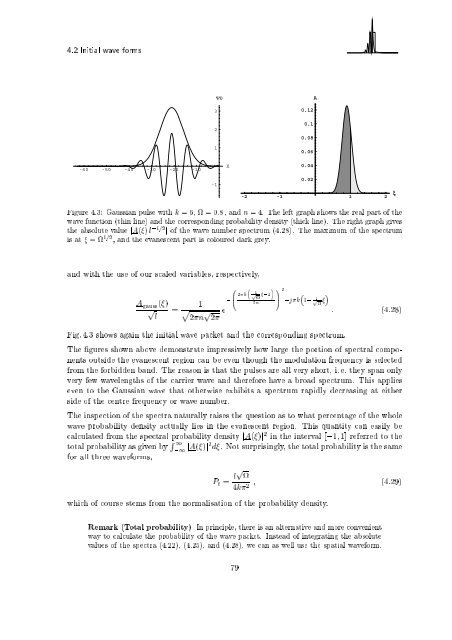Wave Propagation in Linear Media | re-examined
Wave Propagation in Linear Media | re-examined
Wave Propagation in Linear Media | re-examined
You also want an ePaper? Increase the reach of your titles
YUMPU automatically turns print PDFs into web optimized ePapers that Google loves.
4.2 Initial wave forms<br />
-60 -50 -40 -30 -20 -10<br />
3<br />
2<br />
1<br />
-1<br />
Ψ0<br />
X<br />
0.12<br />
0.1<br />
0.08<br />
0.06<br />
0.04<br />
0.02<br />
A<br />
-2 -1 1 2 ξ<br />
-2 -1 1 2 ξ<br />
Figu<strong>re</strong> 4.3: Gaussian pulse with k =6, =0:8 , and n =4. The left graph shows the <strong>re</strong>al part of the<br />
wave function (th<strong>in</strong> l<strong>in</strong>e) and the cor<strong>re</strong>spond<strong>in</strong>g probability density (thick l<strong>in</strong>e). The right graph gives<br />
the absolute value jA( ) l ,1=2 j of the wave number spectrum (4.28). The maximum of the spectrum<br />
is at = 1=2 , and the evanescent part is colou<strong>re</strong>d dark g<strong>re</strong>y.<br />
and with the use of our scaled variables, <strong>re</strong>spectively,<br />
A gauss ( )<br />
p l<br />
=<br />
1<br />
p 2 n p 2 e<br />
,<br />
0<br />
@ 2 k p 1<br />
,1<br />
2n<br />
1<br />
A 2<br />
,j k 1, 1<br />
p<br />
Fig. 4.3 shows aga<strong>in</strong> the <strong>in</strong>itial wave packet and the cor<strong>re</strong>spond<strong>in</strong>g spectrum.<br />
: (4.28)<br />
The gu<strong>re</strong>s shown above demonstrate imp<strong>re</strong>ssively how large the portion of spectral components<br />
outside the evanescent <strong>re</strong>gion can be even though the modulation f<strong>re</strong>quency is selected<br />
from the forbidden band. The <strong>re</strong>ason is that the pulses a<strong>re</strong> all very short, i. e. they span only<br />
very few wavelengths of the carrier wave and the<strong>re</strong>fo<strong>re</strong> have a broad spectrum. This applies<br />
even to the Gaussian wave that otherwise exhibits a spectrum rapidly dec<strong>re</strong>as<strong>in</strong>g at either<br />
side of the cent<strong>re</strong> f<strong>re</strong>quency or wave number.<br />
The <strong>in</strong>spection of the spectra naturally raises the question as to what percentage of the whole<br />
wave probability density actually lies <strong>in</strong> the evanescent <strong>re</strong>gion. This quantity can easily be<br />
calculated from the spectral probability density jA( )j 2 <strong>in</strong> the <strong>in</strong>terval [,1; 1] <strong>re</strong>fer<strong>re</strong>d to the<br />
total probability as given by R 1<br />
,1 jA( )j2 d . Not surpris<strong>in</strong>gly, the total probability is the same<br />
for all th<strong>re</strong>e waveforms,<br />
Pt = lp<br />
4k<br />
2 ; (4.29)<br />
which of course stems from the normalisation of the probability density.<br />
Remark (Total probability) In pr<strong>in</strong>ciple, the<strong>re</strong> is an alternative and mo<strong>re</strong> convenient<br />
way to calculate the probability of the wave packet. Instead of <strong>in</strong>tegrat<strong>in</strong>g the absolute<br />
values of the spectra (4.22), (4.25), and (4.28), we can as well use the spatial waveform.<br />
79












